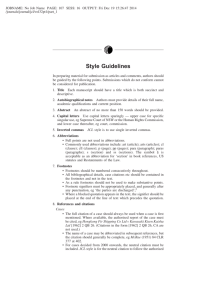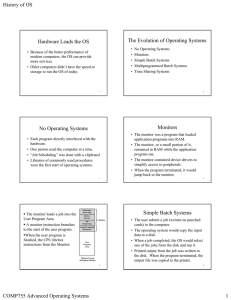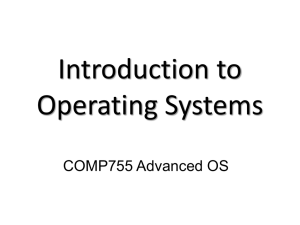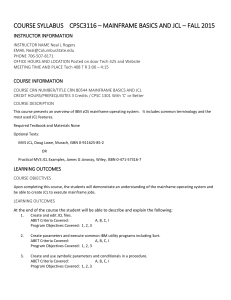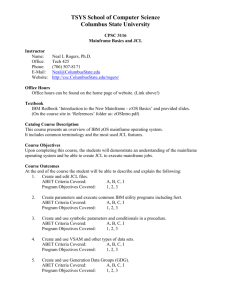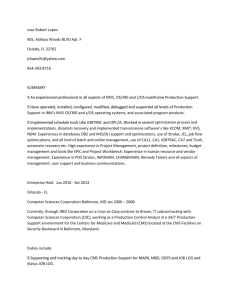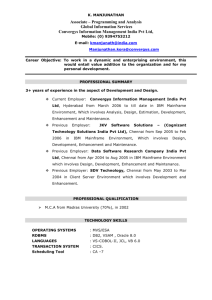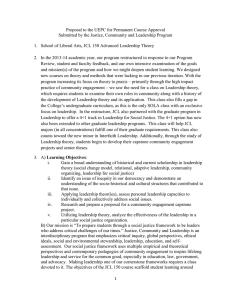Document 10815529
advertisement
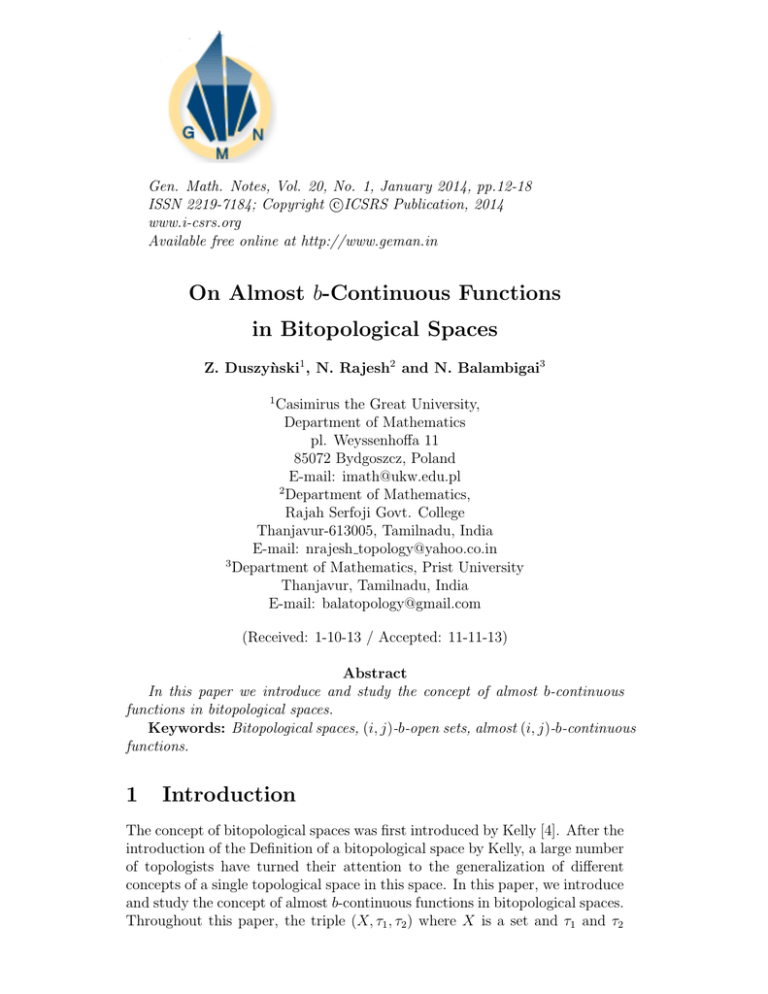
Gen. Math. Notes, Vol. 20, No. 1, January 2014, pp.12-18
c
ISSN 2219-7184; Copyright ICSRS
Publication, 2014
www.i-csrs.org
Available free online at http://www.geman.in
On Almost b-Continuous Functions
in Bitopological Spaces
Z. Duszyǹski1 , N. Rajesh2 and N. Balambigai3
1
Casimirus the Great University,
Department of Mathematics
pl. Weyssenhoffa 11
85072 Bydgoszcz, Poland
E-mail: imath@ukw.edu.pl
2
Department of Mathematics,
Rajah Serfoji Govt. College
Thanjavur-613005, Tamilnadu, India
E-mail: nrajesh topology@yahoo.co.in
3
Department of Mathematics, Prist University
Thanjavur, Tamilnadu, India
E-mail: balatopology@gmail.com
(Received: 1-10-13 / Accepted: 11-11-13)
Abstract
In this paper we introduce and study the concept of almost b-continuous
functions in bitopological spaces.
Keywords: Bitopological spaces, (i, j)-b-open sets, almost (i, j)-b-continuous
functions.
1
Introduction
The concept of bitopological spaces was first introduced by Kelly [4]. After the
introduction of the Definition of a bitopological space by Kelly, a large number
of topologists have turned their attention to the generalization of different
concepts of a single topological space in this space. In this paper, we introduce
and study the concept of almost b-continuous functions in bitopological spaces.
Throughout this paper, the triple (X, τ1 , τ2 ) where X is a set and τ1 and τ2
On Almost b-Continuous Functions...
13
are topologies on X, will always denote a bitopological space. For a subset A
of a bitopological space (X, τ1 , τ2 ), the closure of A and the interior of A with
respect to τi are denoted by iCl(A) and iInt(A), respectively, for i = 1, 2.
2
Preliminaries
Definition 2.1 A subset A of a bitopological space (X, τ1 , τ2 ) is said to be:
1. (i, j)-semiopen [3] if A ⊂ jCl(iInt(A)),
2. (i, j)-semi-preopen [6] if A ⊂ jCl(iInt(jCl(A))),
3. (i, j)-b-open [1] if A ⊂ jCl(iInt(A)) ∪ iInt(jCl(A)),
4. (i, j)-regular open [2] if A = iInt(jCl(A)),
On each definition above, i, j = 1, 2 and i 6= j.
The complement of an (i, j)-semiopen (resp. (i, j)-semi-preopen, (i, j)-b-open,
(i, j)-regular open) set is called an (i, j)-semiclosed (resp. (i, j)-semi-preclosed,
(i, j)-b-closed, (i, j)-regular closed) set.
Definition 2.2 [1] Let A be a subset of a bitopological space (X, τ1 , τ2 ).
Then the intersection of all (i, j)-b-closed sets of X containing A is called the
(i, j)-b-closure of A and is denoted by (i, j)-bCl(A). The union of all (i, j)-bopen sets of X contained in A is called the (i, j)-b-interior of A and is denoted
by (i, j)-bInt(A).
Definition 2.3 A point x of X is said to be the (i, j)-δ-cluster point [5] of
A if A ∩ U 6= ∅ for every (i, j)-regular open set U containing x, the set of all
(i, j)-δ-cluster points of A is called the (i, j)-δ-closure of A, a subset A of X is
said to be (i, j)-δ-closed if the set of all (i, j)-δ-cluster points of A is a subset
of A, the complement of an (i, j)-δ-closed set is an called an (i, j)-δ-open set
or a subset A of X is called (i, j)-δ-open if and only if there exist (i, j)-regular
open sets Ak , k ∈ I such that A = ∪ Ak .
k∈I
Lemma 2.4 [1] Let (X, τ1 , τ2 ) be a bitopological space and A a subset of X.
Then
1. (i, j)-bInt(A) is an (i, j)-b-open set;
2. (i, j)-bCl(A) is an (i, j)-b-closed set;
3. A is (i, j)-b-open if and only if A = (i, j)-bInt(A);
14
Z. Duszyǹski et al.
4. A is (i, j)-b-closed if and only if A = (i, j)-bCl(A);
5. (i, j)-bInt(X\A) = X\(i, j)-bCl(A);
6. (i, j)-bCl(X\A) = X\(i, j)-bInt(A).
Lemma 2.5 [1] Let (X, τ1 , τ2 ) be a bitopological space and A ⊂ X. A
point x ∈ (i, j)-bCl(A) if and only if U ∩ A 6= ∅ for every (i, j)-b-open set U
containing x.
Definition 2.6 A function f : (X, τ1 , τ2 ) → (Y, σ1 , σ2 ) is said to be (i, j)b-continuous if f −1 (B) is (i, j)-b-open in X for each σi -open set B of Y .
3
Almost (i, j)-b-Continuous Functions
Definition 3.1 A function f : (X, τ1 , τ2 ) → (Y, σ1 , σ2 ) is called an almost
(i, j)-b-continuous at a point x ∈ X if for each σi -open set V of Y containing
f (x), there exists an (i, j)-b-open set U of X containing x such that f (U ) ⊂
iInt(jCl(V )). If f is almost (i, j)-b-continuous at every point x of X, then it
is called almost (i, j)-b-continuous.
It is obvious from the definition that (i, j)-b-continuity implies almost (i, j)b-continuity. However, the converse is not true in general as it is shown in the
following example.
Example 3.2 Let X = {a, b, c, d}, τ1 = {∅, {a}, X}, τ2 = {∅, {b, c}, X},
σ1 = {∅, {a}, X} and σ2 = {∅, {a, b}, X}. Then the function f : (X, τ1 , τ2 ) →
(Y, σ1 , σ2 ) defined by f (a) = d, f (b) = b f (c) = c and f (d) = a is almost
(i, j)-b-continuous but not (i, j)-b-continuous.
Theorem 3.3 For a function f : (X, τ1 , τ2 ) → (Y, σ1 , σ2 ), the following
statements are equivalent:
1. f is almost (i, j)-b-continuous.
2. For each x ∈ X and each (i, j)-regular open set V of Y containing f (x),
there exists an (i, j)-b-open U in X containing x such that f (U ) ⊂ V .
3. For each x ∈ X and each (i, j)-δ-open set V of Y containing f (x), there
exists an (i, j)-b-open U in X containing x such that f (U ) ⊂ V .
Proof: (1) ⇒ (2): Let x ∈ X and let V be any (i, j)-regular open subset of Y
containing f (x). By (1), there exists an (i, j)-b-open set U of X containing x
such that f (U ) ⊂ iInt(jCl(V )). Since V is (i, j)-regular open, iInt(jCl(V )) =
V . Therefore, f (U ) ⊂ V .
On Almost b-Continuous Functions...
15
(2) ⇒ (3): Let x ∈ X and let V be any (i, j)-δ-open set of Y containing f (x).
Then for each f (x) ∈ V , there exists a σi -open set G containing f (x) such
that G ⊂ iInt(jCl(G)) ⊂ V . Since iInt(jCl(G)) is (i, j)-regular open set of
Y containing f (x). By (2), there exists an (i, j)-b-open set U in X containing
x such that f (U ) ⊂ iInt(jCl(G)) ⊂ V .
(3) ⇒ (1): Let x ∈ X and let V be any σi -open set of Y containing f (x).
Then iInt(jCl(V )) is (i, j)-δ-open set of Y containing f (x). By (3), there
exists an (i, j)-b-open set U in X containing x such that f (U ) ⊂ iInt(jCl(V )).
Therefore, f is almost (i, j)-b-continuous.
Theorem 3.4 For a function f : (X, τ1 , τ2 ) → (Y, σ1 , σ2 ), the following
statements are equivalent:
1. f is almost (i, j)-b-continuous.
2. f −1 (iInt(jCl(V ))) is (i, j)-b-open set in X for each σi -open set V in Y .
3. f −1 (iCl(jInt(F ))) is (i, j)-b-closed set in X for each σi -closed set F in
Y.
4. f −1 (F ) is (i, j)-b-closed set in X for each (i, j)-regular closed set F of
Y.
5. f −1 (V ) is (i, j)-b-open set in X for each (i, j)-regular open set V of Y .
Proof: (1) ⇒ (2): Let V be any σi -open set in Y . We have to show that
f −1 (iInt(jCl(V ))) is (i, j)-b-open set in X. Let x ∈ f −1 (iInt(jCl(V ))). Then
f (x) ∈ iInt(jCl(V )) and iInt(jCl(V )) is an (i, j)-regular open set in Y . Since
f is almost (i, j)-b-continuous, by Theorem 3.3, there exists an (i, j)-b-open
set U of X containing x such that f (U ) ⊂ iInt(jCl(V )). Which implies that
x ∈ U ⊂ f −1 (iInt(jCl(V ))). Therefore, f −1 (iInt(jCl(V ))) is an (i, j)-b-open
set in X.
(2) ⇒ (3): Let F be any σi -closed set of Y . Then Y \F is a σi -open set of Y . By
(2), f −1 (iInt(jCl(Y \F ))) is an (i, j)-b-open set in X and f −1 (iInt(jCl(Y \F ))) =
X\f −1 (iCl(jInt(F ))) is an (i, j)-b-open set in X and hence f −1 (iCl(jInt(F )))
is an (i, j)-b-closed set in X.
(3) ⇒ (4): Let F be any (i, j)-regular closed set of Y . Then F is a σi -closed
set of Y . By (3), f −1 (iCl(jInt(F ))) is an (i, j)-b-closed set in X. Since F
is (i, j)-regular closed, f −1 (iCl(jInt(F ))) = f −1 (F ). Therefore, f −1 (F ) is an
(i, j)-b-closed set in X.
(4) ⇒ (5): Let V be any (i, j)-regular open set of Y . Then Y \V is an (i, j)regular closed set of Y and by (4), we have f −1 (Y \V ) = X\f −1 (V ) is (i, j)-bclosed set in X and hence f −1 (V ) is (i, j)-b-open in X.
(5) ⇒ (1): Let x ∈ X and let V be any (i, j)-regular open set of Y containing
16
Z. Duszyǹski et al.
f (x). Then x ∈ f −1 (V ). By (5), we have f −1 (V ) is (i, j)-b-open set in X.
Therefore, we obtain f (f −1 (V )) ⊂ V . Hence by Theorem 3.3, f is almost
(i, j)-b-continuous.
Theorem 3.5 For a function f : (X, τ1 , τ2 ) → (Y, σ1 , σ2 ), the following
statements are equivalent:
1. f is almost (i, j)-b-continuous.
2. (i, j)-bCl(f −1 (V )) ⊂ f −1 (iCl(V )) for each (j, i)-semi-preopen set V of
Y.
3. f −1 (iInt(F )) ⊂ (i, j)-bInt(f −1 (F )) for each (j, i)-semi-preclosed set F
of Y
4. f −1 (iInt(F )) ⊂ (i, j)-bInt(f −1 (F )) for each (j, i)-semiclosed set F of Y .
5. (i, j)-bCl(f −1 (V )) ⊂ f −1 (iCl(V )) for each (j, i)-semiopen set V of Y .
Proof: (1) ⇒ (2): Let V be any (j, i)-semi-preopen set of Y . Since iCl(V ) is
an (i, j)-regular closed set in Y and f is almost (i, j)-b-continuous, by Theorem
3.4, f −1 (V ) is (i, j)-b-closed set in X.
Therefore, (i, j)-bCl(f −1 (V )) ⊂ f −1 (jCl(V )). (2) ⇒ (3) and (3)⇒ (4) are
clear.
(4) ⇒ (5): Let V be any (j, i)-semiopen set of Y . Then Y \V is (j, i)-semiclosed
set and by (4), we have f −1 (iInt(Y \V )) ⊂ (i, j)-bInt(f −1 (Y \V )) ⊂ X\(i, j)bCl(f −1 (V )). Therefore, (i, j)-bCl(f −1 (V )) ⊂ f −1 (iCl(V )).
(5) ⇒ (1): Let F be any (i, j)-regular closed set of Y . Then F is an (j, i)semiopen set of Y . By (5), we have (i, j)-bCl(f −1 (F )) ⊂ f −1 (jCl(F )) =
f −1 (F ). This shows that f −1 (F ) is (i, j)-b-closed set in X. Therefore, by
Theorem 3.4, f is almost (i, j)-b-continuous.
Theorem 3.6 A function f : (X, τ1 , τ2 ) → (Y, σ1 , σ2 ) is almost (i, j)-bcontinuous if and only if f −1 (V ) ⊂ (i, j)-bInt(f −1 (iInt(jCl(V )))) for each
σi -open set V of Y .
Proof: Let V be any σi -open set of Y . Then V ⊂ iInt(jCl(V )) and iInt(jCl(V ))
is (i, j)-regular open set in Y . Since f is almost (i, j)-b-continuous, by Theorem 3.4, f −1 (iInt(jCl(V ))) is (i, j)-b-open set in X and hence we obtain
that f −1 (V ) ⊂ f −1 (iInt(jCl(V ))) = (i, j)-bInt(f −1 (iInt(jCl(V )))). Conversely, let V be any (i, j)-regular open set of Y . Then V is σi -open set of
Y . By hypothesis, we have f −1 (V ) ⊂ (i, j)-bInt(f −1 (iInt(jCl(V )))) = (i, j)bInt(f −1 (V )). Therefore, f −1 (V ) is (i, j)-b-open set in X and hence by Theorem 3.4, f is almost (i, j)-b-continuous.
On Almost b-Continuous Functions...
17
Corollary 3.7 A function f : (X, τ1 , τ2 ) → (Y, σ1 , σ2 ) is almost (i, j)-bcontinuous if and only if (i, j)-bCl(f −1 (jCl(iInt(F )))) ⊂ f −1 (F ) for each σi closed set F of Y .
Theorem 3.8 Let f : (X, τ1 , τ2 ) → (Y, σ1 , σ2 ) be an almost (i, j)-b-continuous
function and V ∈ σi ∩σj . If x ∈ (i, j)-bCl(f −1 (V ))\f −1 (V ), then f (x) ∈ (i, j)bCl(V ).
Proof: Let x ∈ X be such that x ∈ (i, j)-bCl(f −1 (V ))\f −1 (V ) and suppose
f (x) ∈
/ (i, j)-bCl(V ). Then there exists an (i, j)-b-open set H containing f (x)
such that H ∩V = ∅. Then iInt(jCl(H))∩V = ∅ and iInt(jCl(H)) is an (i, j)regular open set. Since f is almost (i, j)-b-continuous, by Theorem 3.4, there
exists an (i, j)-b-open set U in X containing x such that f (U ) ⊂ iInt(jCl(H)).
Therefore, f (U ) ∩ V = ∅. However, since x ∈ (i, j)-bCl(f −1 (V )), U ∩ f −1 (V ) 6=
∅ for every (i, j)-b-open set U in X containing x, so that f (U ) ∩ V 6= ∅. We
have a contradiction. It follows that f (x) ∈ (i, j)-bCl(V ).
Definition 3.9 Let (X, τ1 , τ2 ) be a bitopological space and A a subset of X.
The (i, j)-b-frontier of A, (i, j)-bF r(A), is defined by (i, j)-bF r(A) = (i, j)bCl(A) ∩ (i, j)-bCl(X\A) = (i, j)-bCl(A)\(i, j)-bInt(A)
Theorem 3.10 The set of all points x of X at which f : (X, τ1 , τ2 ) →
(Y, σ1 , σ2 ) is not almost (i, j)-b-continuous is identical with the union of the
(i, j)-b-frontiers of the inverse images of (i, j)-regular open subsets of Y containing f (x).
Proof: If f is not almost (i, j)-b-continuous at x ∈ X, then there exists an (i, j)regular open set V containing f (x) such that for every (i, j)-b-open set U of X
containing x, f (U ) ∩ (Y \V ) 6= ∅. This means that for every (i, j)-b-open set U
of X containing x, we must have U ∩(X\f −1 (V )) 6= ∅. Hence it follows that x ∈
(i, j)-bCl(X\f −1 (V )). But x ∈ f −1 (V ) and hence x ∈ (i, j)-bCl(f −1 (V )). This
means that x belongs to the (i, j)-b-frontier of f −1 (V ). Conversely, suppose
that x belongs to the (i, j)-b-frontier of f −1 (V1 ) for some (i, j)-regular open
subset V1 of Y such that f (x) ∈ V1 . Suppose that f is almost (i, j)-b-continuous
at x. Then by Theorem 3.3, there exists an (i, j)-b-open set U of X containing
x such that f (U ) ⊂ V1 . Then we have U ⊂ f −1 (V1 ). This shows that x ∈ (i, j)bInt(f −1 (V1 )). Therefore, we have x ∈
/ (i, j)-bCl(X\f −1 (V1 )) and x ∈
/ (i, j)−1
bF r(f (V1 )), which is a contradiction. This means that f is not almost
(i, j)-b-continuous.
References
[1] N. Balambigai, N. Rajesh and J.M. Mustafa, On b-open sets in bitopological spaces (under preparation).
18
Z. Duszyǹski et al.
[2] S. Bose and S.P. Sinha, Almost open, almost closed, θ-continuous and
almost compact mapping in bitopological spaces, Bull. Calcutta. Math.
Soc., 73(1981), 345-354.
[3] S. Bose, Semiopen sets, Semicontinuity and semiopen mappings in bitopological spaces, Bull. Cal. Math. Soc., 73(1981), 237-246.
[4] J.C. Kelly, Bitopological spaces, Proc. London Math. Soc., 13(1963), 7189.
[5] F.H. Khedr and A.M. Alshibani, On pairwise super continuous mapping in
bitopological spaces, Internat. J. Math. Math. Sci., 14(4) (1991), 715-722.
[6] F.H. Khedr, S.M. Al.Areefi and T. Noiri, Precontinuity and semiprecontinuity in bitopological spaces, Indian J. Pure Appl. Math., 23(9)
(1992), 625-633.
